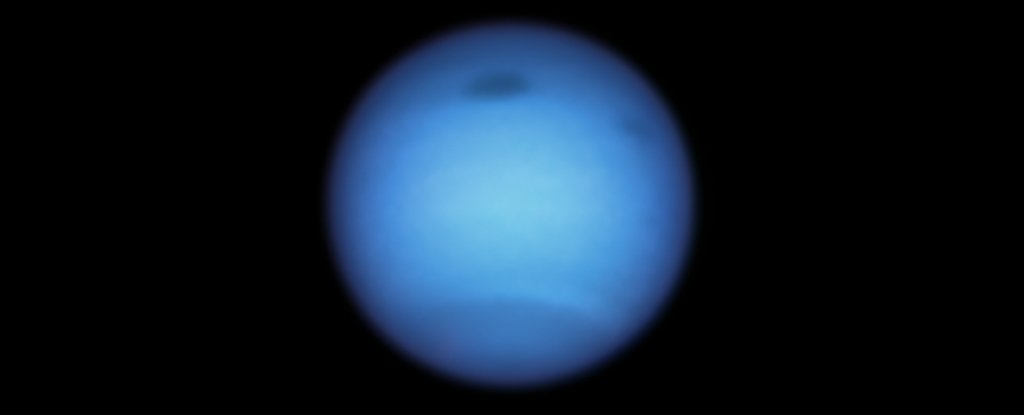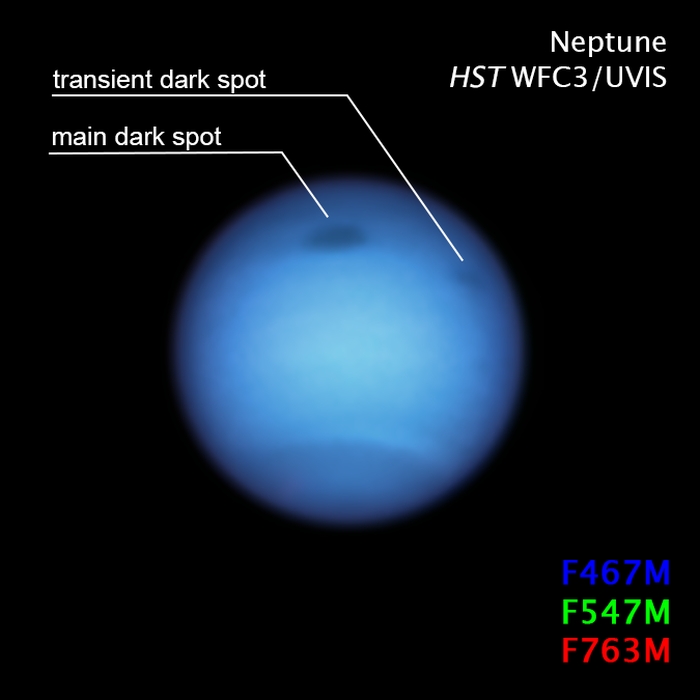
Posted on 12/17/2020 8:10:43 AM PST by Red Badger

(NASA, ESA, STScI, M.H. Wong/UC Berkeley, and L.A. Sromovsky & P.M. Fry/University of Wisconsin-Madison)
Jupiter may have the most famous storm in the Solar System, but that doesn't mean it gets all the fun - and Neptune has just presented scientists with a doozy.
Although storm vortices aren't unusual on the distant ice giant, this is the first time one has been observed turning back towards the polar region after migrating towards the equator.
Astronomers still aren't sure how, or why, it managed to change course, but figuring it out could tell us more about Neptune's atmospheric dynamics.
Neptune is actually pretty hard to see compared to the other planets in the Solar System. It's way out from the Sun, at an averaged distance 30 times that between Earth and the Sun, which makes it tricky to make out much detail. So it wasn't until 1989, when Voyager 2 made its flyby, that two storms were discovered on Neptune.
Since then, Hubble - the only instrument capable of doing so - has observed and tracked four more of these storms, named Dark Spots, for their darker hue than the surrounding atmosphere.
Generally, their behaviour has been pretty similar: they appear at mid-latitudes, they hang around for about two years while migrating towards the equator, and then they dissipate. Then, four to six years later, another shows up.
This storm, however, the fourth observed by Hubble, called NDS-2018, has been the exception.
"It was really exciting to see this one act like it's supposed to act and then all of a sudden it just stops and swings back," said planetary scientist Michael Wong of the University of California, Berkeley. "That was surprising."
NDS-2018, as the name suggests, was first discovered in 2018. By that time, it had been growing for several years, and measured around 11,000 kilometres (6,800 miles) across.
When Hubble observed it again in January 2020, it was behaving as expected, migrating southwards towards the equator from the northern mid-latitudes.
As it migrated, the Coriolis effect keeping the storm stable at mid-latitudes was expected to weaken, gradually disappearing by the time the storm reached the equator. Then, according to simulations, and previous observations, NDS-2018 should have faded into oblivion.
But those January observations revealed something strange - a slightly smaller dark smudge like a miniature version of the larger storm. NDS-2018 was, by that time, around 7,400 kilometres (4,600 miles) across. Dark Spot Jr., as it was nicknamed, was around 6,275 kilometres (3,900 miles) across.
Then, in August this year, when Hubble took another look at NDS-2018 (it's a very busy telescope and can't just stare at Neptune all the time), the storm was making its way north again. Dark Spot Jnr. was gone.

(NASA, ESA, STScI, M.H. Wong/UC Berkeley, and L.A. Sromovsky & P.M. Fry/University of Wisconsin-Madison)
==========================================================
"We are excited about these observations because this smaller dark fragment is potentially part of the dark spot's disruption process," Wong said.
"This is a process that's never been observed. We have seen some other dark spots fading away, and they're gone, but we've never seen anything disrupt, even though it's predicted in computer simulations."
It's impossible to know exactly what happened, but the appearance and subsequent disappearance of Dark Spot Jr. might be a clue. For one thing, it was near the side of NDS-2018 that was closer to the equator. According to simulations, if anything were to disrupt a Neptunian storm, that's where it would happen.
The fact that Dark Spot Jr. showed up when it did could be a clue, too.
"When I first saw the small spot, I thought the bigger one was being disrupted. I didn't think another vortex was forming, because the small one is farther towards the equator. So it's within this unstable region. But we can't prove the two are related. It remains a complete mystery," Wong said.
"It was also in January that the dark vortex stopped its motion and started moving northward again. Maybe by shedding that fragment, that was enough to stop it from moving towards the equator."
There's still a lot we don't know about Neptune's dark spots. They are pretty empty of clouds in the middle, compared to storm vortices on Saturn and Jupiter. The clouds we can detect are fluffy white clouds that appear around the edges, probably as a result of gases freezing into methane ice crystals as they are lifted up from lower altitudes.
On that score, NDS-2018 provides yet another mystery: its fluffy white companion clouds disappeared when the storm changed direction.
This could reveal more information about how Neptunian storms evolve, the researchers say. Meanwhile, they're also looking more closely at available data to see if they can find any more information on Dark Spot Jr., to check if the smaller storm, or bits of it, may have hung around a bit longer.
When Hubble next swings its shiny eye towards Neptune as part of the Outer Planet Atmospheres Legacy program, scientists will be very interested indeed to see what NDS-2018 is doing.
The team's research was presented at the 2020 Fall Meeting of the American Geophysical Union.
What the...............we DON’T know everything?!
Picked it up from Uranus!

Must be because of fossil fuel emissions from the Neptunian SUV manufacturers.
Obviously global warming.
Far out, man.
Disclaimer: Opinions posted on Free Republic are those of the individual posters and do not necessarily represent the opinion of Free Republic or its management. All materials posted herein are protected by copyright law and the exemption for fair use of copyrighted works.